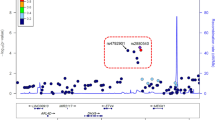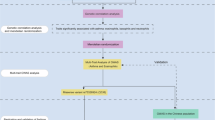Abstract
Eotaxin family (Eotaxin 1,2 and 3) recruits and activates CCR3-bearing cells such as eosinophil, mast cells, and Th2 lymphocytes that play a major role in allergic disorders. We examined the polygenetic effects of the Eotaxin gene family in a Korean population. Gene–gene interactions were tested using a multistep approach with multifactor dimensionality reduction (MDR) method between asthmatics and normal controls. The overall best MDR model of the main effect single nucleotide polymorphisms (SNPs) included EOT2 + 1272A > G and EOT3 + 77C > T (model 1) [testing accuracy 0.597, cross-validation consistency (CVC) 10/10, P < 0.001]. The overall best MDR model of the SNPs with no main effects included EOT2 + 304C > A, EOT3 + 716A > G, and EOT3 + 1579G > A (model 2) (testing accuracy 0.616, CVC 10/10, P < 0.001). Model 3 was obtained by including the MDR variables for models 1 and 2. This new composite model predicted asthma with better accuracy than either model 1 or model 2 (testing accuracy 0.643, CVC 10/10, P < 0.001). The detection of statistical interaction models is one evidence of gene–gene interactions among Eotaxin genes, and this interaction is thought to influence the development of asthma. Although the models are limited to determining statistical interactions within a population, they may be useful for identifying groups at high risk of developing asthma.
Similar content being viewed by others
Log in or create a free account to read this content
Gain free access to this article, as well as selected content from this journal and more on nature.com
or
Abbreviations
- MDR:
-
multifactor dimensionality reduction
- CVC:
-
cross-validation consistency
- OR:
-
odds ratio
References
Andrew AS, Nelson HH, Kelsey KT, Moore JH, Meng AC, Casella DP, Tosteson TD, Schned AR, Karagas MR (2006) Concordance of multiple analytical approaches demonstrates a complex relationship between DNA repair gene SNPs, smoking and bladder cancer susceptibility. Carcinogenesis 27:1030–1037
Berkman N, Ohnona S, Chung FK, Breuer R (2001) Eotaxin-3 but not eotaxin gene expression is upregulated in asthmatics 24 hours after allergen challenge. Am J Respir Cell Mol Biol 24:682–687
Brown JR, Kleimberg J, Marini M, Sun G, Bellini A, Mattoli S (1998) Kinetics of eotaxin expression and its relationship to eosinophil accumulation and activation in bronchial biopsies and bronchoalveolar lavage (BAL) of asthmatic patients after allergen inhalation. Clin Exp Immunol 114:137–146
Carlson CS, Eberle MA, Kruglyak L, Nickerson DA (2004) Mapping complex disease loci in whole-genome association studies. Nature 429:446–452
Chung Y, Lee SY, Elston RC, Park T (2007) Odds ratio based multifactor-dimensionality reduction method for detecting gene–gene interactions. Bioinformatics 23:71–76
Davies DE, Wicks J, Powell RM, Puddicombe SM, Holgate ST (2003) Airway remodeling in asthma: new insights. J Allergy Clin Immunol 111:215–225
Faffe DS, Flynt L, Mellema M, Moore PE, Silverman ES, Subramaniam V, Jones MR, Mizgerd JP, Whiterhead T, Imrich A, Panettieri RA, Shore SA (2005) Oncostatin M causes eotaxin-1 release from airway smooth muscle: synergy with IL-4 and IL-13. J Allergy Clin Immunol 115:514–520
Ferris BG (1978) Epidemiology standardization project (American Thoracic Society). Am Rev Respir Dis 118:1–120
Hahn LW, Moore JH (2004) Ideal discrimination of discrete clinical endpoints using multilocus genotypes. In Silico Biol 4:183–194
Hahn LW, Rithchie MD, Moore JH (2003) Multifactor dimensionality reduction software for detecting gene–gene and gene–environmental interactions. Bioinformatics 19:372–382
Hedric PW (1978) Gametic disequilibrium measures: proceed with caution. Genetics 117:331–341
Ioannidis JP (2007) Non-replication and inconsistency in the genome-wide association setting. Hum Hered 64:203–213
Jakulin A, Bratko I, Smrke D, Demsar J, Zupan B (2003) Attribute interactions in medical data analysis. Lect Notes Artif Intell 2780:229–238
Langdon C, Kerr C, Tong L, Richards CD (2003) Oncostatin m regulates eotaxin expression in fibroblasts and eosinophilic inflammation in C57BL/6 mice. J Immunol 170:548–555
Lou XY, Chen GB, Yan L, Ma JZ, Zhu J, Elston RC, Li MD (2007) A generalized combinatorial approach for detecting gene–by–gene and gene–by–environment interactions with application to nicotine dependence. Am J Hum Genet 80:1125–1137
Matsukura S, Kokubu F, Kuga H, Kawaguchi M, Ieki K, Odaka M, Suzuki S, Watanabe S, Takeuchi H, Adachi M, Stellato C, Schleimer RP (2003) Differential regulation of eotaxin expression by IFN-gamma in airway epithelial cells. J Allergy Clin Immunol 111:1337–1344
Min JW, Lee JH, Park CS, Chang HS, Rhim TY, Park SW, Jang AS, Shin HD (2005) Association of eotaxin-2 gene polymorphisms with plasma eotaxin-2 concentration. J Hum Genet 50:118–123
Moore JH, Ritchie MD (2004) The challenges of whole-genome approaches to common disease. J Am Med Assoc 291:1642–1643
Moore JH, Gilbert JC, Tsai CT, Chiang FT, Holden T, Barney N, White BC (2006) A flexible computational framework for detecting, characterizing, and interpreting statistical patterns of epistasis in genetic studies of human disease susceptibility. J Theor Biol 241:252–261
Moore JH, Barney N, Tsai CT, Chiang FT, Gui J, White BC (2007) Symbolic modeling of epistasis. Hum Hered 632:120–133
Papadopoulos NG, Papai A, Meyer J, Stanciu LA, Salvi S, Holgate ST, Johnston SL (2001) Rhinovirus infection up-regulates eotaxin and eotaxin-2 expression in bronchial epithelial cells. Clin Exp Allergy 31:1060–1066
Pompe SM, Fulkerson PC, Blanchard C, Akei HS, Niklaidis NM, Zimmermann N, Molkentin J, Rothenberg ME (2005) Identification of a cooperative mechanism involving interleukin-13 and eotaxin-2 in experimental allergic lung inflammation. J Biol Chem 280:13952–13961
Rankin SM, Conroy DM, Williams TJ (2000) Eotaxin and eosinophil recruitment: implications for human disease. Mol Med Today 6:20–27
Rice SH (2002) A general population genetic theory for the evolution of developmental interactions. Proc Natl Acad Sci USA 99:15518–15523
Ritchie MD, Hahn LW, Roodi N, Bailey R, Dupont WD, Parl FF, Moore JH (2001) Multifactor-dimensionality reduction reveals high-order interactions among estrogen-metabolism genes in sporadic breast cancer. Am J Hum Genet 69:138–147
Ritchie MD, Hahn LW, Moore JH (2003) Power of multifactor dimensionality reduction for detecting gene-gene interactions in the presence of genotyping error, missing data, phenocopy, and genetic heterogeneity. Gent Epidemiol 24:150–157
Robert OC, John LH, Charles I, Neil RM, Karen ZV, Robert AW (1987) Standards for the diagnosis and care of patients with chronic obstructive pulmonary disease (COPD) and asthma. Am Rev Respir Dis 136:225–244
Robert OC, Richard C, Allan LC, Paul LE, John LH, Charles GI, Neil RM, Roy TM, Jask SW (1999) Guidelines for methacholine and exercise challenge testing-1999. Am J Respir Crit Care Med 161:309–329
Shin HD, Kim LH, Park BL, Jung JH, Kim JY, Chung IY, Kim JS, Lee JH, Chung SH, Kim YH, Park HS, Choi JH, Lee YM, Park SW, Choi BW, Hong SJ, Park CS (2003) Association of Eotaxin gene family with asthma and serum total IgE. Hum Mol Genet 12:1279–1285
Steinke JW, Rich SS, Borish L (2008) 5. Genetics of allergic disease. J Allergy Clin Immunol 121:S384–S387
Stephan M, Smith NJ, Donnelly P (2001) A new statistical method for haplotype reconstruction from population data. Am J Hum Genet 68:978–989
Strohman R (2002) Maneuvering in the complex path from genotype to phenotype. Science 296:701–703
Wolf JB (2002) The geometry of phenotypic evolution in developmental hyperspace. Proc Natl Acad Sci USA 99:15849–15851
Wolf JB, Brodie EDIII, Wade MJ (2000) Epistasis and the evolutionary process. In: Phillips PC, Otto SP, Whitlock MC (eds) Beyond the average. Oxford, New York, pp 21–22
Ying S, Robinson DS, Meng Q, Barata LT, McEuen AR, Buckley MG, Walls AF, Askenase PW, Kay AB (1999) C–C chemokines in allergen-induced late-phase cutaneous response in atopic subjects: association of eotaxin with early 6-hour eosinophils and of eotaxin-2 and monocyte chemoattractant protein-4 with the later 24-hour tissue eosinophilia, and relationship to basophils and other C–C chemokines (monocyte chemoattractant protein-3 and RANTES). J Immunol 163:3976–3984
Acknowledgments
This work was supported by a grant of the Korea Health 21 R&D Project, Ministry of Health and Welfare, Republic of Korea (01-PJ3-PG6-01GN04-003) and Soonchunhyang University Research Fund (20050000). The English in this document has been checked by at least two professional editors, both native speakers of English. For a certificate, see: http://www.textcheck.com/cgi-bin/certificate.cgi?id=TVT7r8
Author information
Authors and Affiliations
Corresponding author
Rights and permissions
About this article
Cite this article
Lee, JH., Moore, J.H., Park, SW. et al. Genetic interactions model among Eotaxin gene polymorphisms in asthma. J Hum Genet 53, 867–875 (2008). https://doi.org/10.1007/s10038-008-0314-y
Received:
Accepted:
Published:
Issue date:
DOI: https://doi.org/10.1007/s10038-008-0314-y
Keywords
This article is cited by
-
Gene set based association analyses for the WSSV resistance of Pacific white shrimp Litopenaeus vannamei
Scientific Reports (2017)
-
Expression analysis of asthma candidate genes during human and murine lung development
Respiratory Research (2011)
-
Gene–gene interactions contribute to eye colour variation in humans
Journal of Human Genetics (2011)
-
Association of three-gene interaction among MTHFR, ALOX5AP and NOTCH3 with thrombotic stroke: a multicenter case–control study
Human Genetics (2009)



